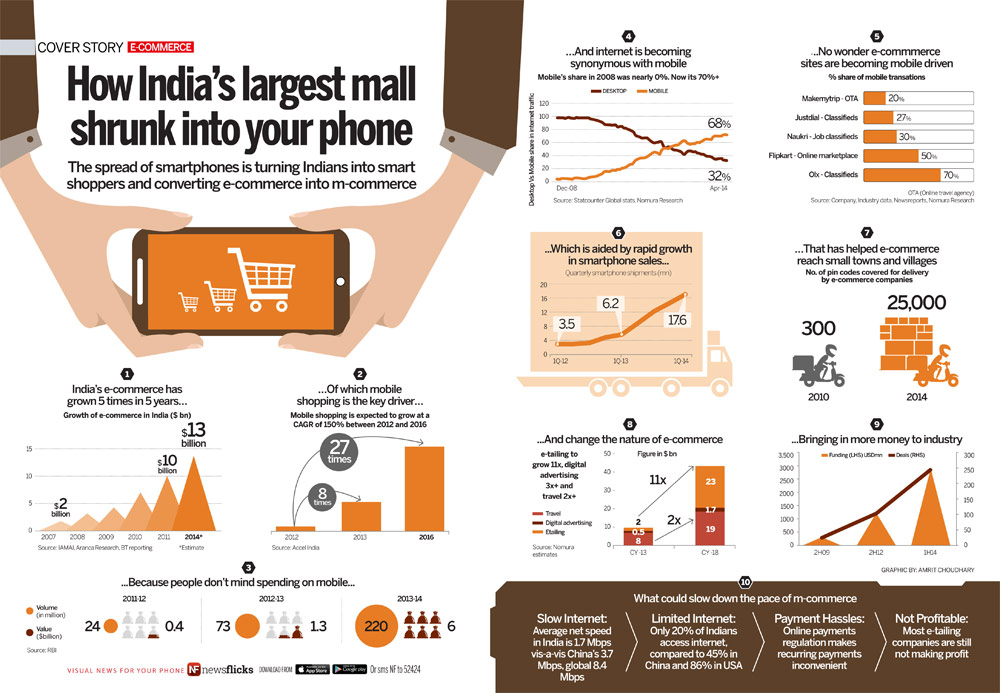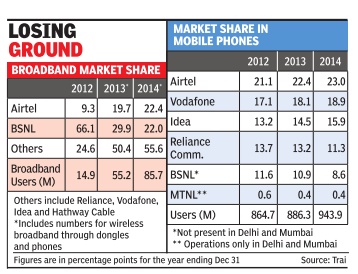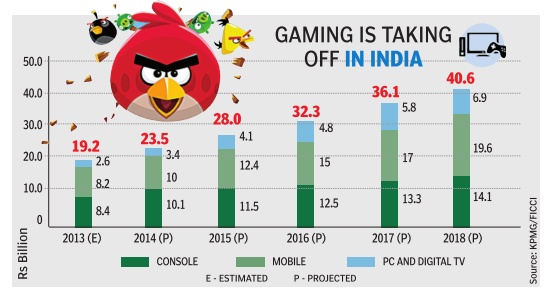Cell/ Mobile phones: India
This is a collection of articles archived for the excellence of their content. Readers will be able to edit existing articles and post new articles directly |
Cell phones: India
Contents |
Subscriber growth

Chennai second among metros in mobile subscriber growth
Ishan Srivastava, TNN | Aug 27, 2013 The Times of India
CHENNAI added 82,296 mobile subscribers in July 2013, the second highest among four metros, according to the latest data released by Telecom Regulatory Authority of India (Trai). With this addition, total number of subscribers in Chennai has reached 1.15 crore. As per the 2011 census, Chennai has a population of 46 lakh.
Chennai's growth is second only to Delhi in that month, which added four lakh users on a subscriber base of 2.8 crore. Mumbai follows Chennai with 81,738 additions and Kolkata added 39,946 to its subscriber base.
Teledensity -- the number of mobile connections relative to population --crossed the 100% mark for the metros in 2009, implying that there were more mobile connections in these cities than the number of residents. The current teledensity in Chennai is nearly 200% or two mobile connections for every person, but the growth shows no signs of slowing down with constant monthly additions. For example, Chennai added 83,290 users in June and 70,444 in May.
Multi-SIM usage, increased migrant population and data consumption are seen as the main reasons driving growth. "A lot of these additions are 'passive' SIMs that people keep just to avail of offers or to enjoy better rates on particular routes and are not in regular use," said Sandip Biswas, director at Deloitte, a consultancy firm. "Operators don't mind it either and are happy with any increase in numbers in such a highly competitive market."
Also, a lot of usage of new SIMs is driven by data consumption where people buy SIMs to access internet on their media devices such as tablets in addition to the one they use for voice, said Milan Sheth, partner at consultancy firm EY.
However, some experts said that subscriber numbers have become less relevant now and what matters is how much data is being consumed by people and how much money is realised by telecom companies through it. "Inactive connections can be as high as 20%-30 % of total ," said Prashant Singhal, partner at EY and who tracks telecom sector.
Tax on chargers
Levy tax on chargers sold with cellphones: SC
Dec 20 2014, The Times of India
AmitAnand Choudhary
The Supreme Court has held that chargers sold with cellphones should be taxed separately as they are not part of a phone but are an accessory and turned down a plea by Nokia for treating them as a composite product.
The SC said merely making one package of a phone and a charger will not make it a composite product and quashed the Punjab and Haryana high court order which held a charger cannot be excluded from the concessional rate of tax which applies to cellphones. The case pertains to Punjab where under state Value Added Tax Act, sale of mobile phone is taxed at 4% while charger is taxed at 12.5%.
“If the charger was a part of cellphone, then cellphone could not have been operated without using the battery charger.But in reality , it is not required at the time of operation. Further, the battery in the cellphone can be charged directly from the other means also like laptop without employing the battery charger, implying thereby , that it is nothing but an accessory to the mobile phone,“ a bench of justices SJ Mukhopadhaya and Madan B Lokur said.
Call registry/ do-not-call registry
Bb SC reflects Times View on pesky calls
Suggests ‘Call Me’ Registry
Dhananjay Mahapatra | TNN From the Archives of ‘‘The Times of India’’: 2008
New Delhi: Those pesky calls may finally dry up. Reacting to a common complaint of millions, the Supreme Court on Thursday maintained that the year-old National Do-Not-Call Registry (NDNCR) has just not worked as telemarketers have continued to breach the citizen’s right to privacy, and suggested that NDNRC should be replaced by a “call registry” — that is, those wishing to receive telemarketers’ calls should register themselves for the purpose.
Remarkably, a little over eight months ago, this newspaper in its Times View had made precisely this suggestion. On the front page on November 18, 2007, we had said, ‘‘There’s a better way out of this mess than trying to make the do-not-call registry work — have a “call registry” instead. In other words, the default option should be that telemarketers cannot make unsolicited calls. Those who wish to receive calls can register themselves on the call register.’’
In response to the suggestion of a bench comprising Justices A K Mathur and Dalveer Bhandari, additional solicitor general Gopal Subramaniam said the Centre would consider it in all seriousness and get back to the court within six weeks. Subramaniam appeared to have been impressed by the suggestion, which he termed as ‘‘weighty’’.
On the issue of pesky calls, the SC has not just been concerned but proactive. Last year it had virtually forced the government to operationalize the “do-not-call registry” while dealing with a PIL filed by one Harsh Pathak accusing service providers of selling their data base to telemarketers who made unsolicited calls.
“In the last one year, we have experienced such calls galore. At least we are victims of it. A year back, you (the Centre) were not willing to implement the regulations. They were implemented after we threatened to do it through our order. After one year, we feel something more needs to be done,” the court said.
Call Dropped
From the Archives of ‘‘The Times of India’’: 2008
A year after the “do-notcall registry” got under way, nearly 8.3m cellphone users have registered
Yet pesky calls continue. It’s time to launch a new registry of people who wish to receive commercial calls, says the Supreme Court
Govt says it is difficult to take action against telemarketers not registered with DoT
SC asks govt to bar unregistered telemarketers from operating
Right to privacy is primary: SC
From the Archives of ‘‘The Times of India’’: 2008
New Delhi: The SC on Thursday maintained that the yearold ‘National Do-Not-Call Registry’ (NDNCR) has just not worked as telemarketers have continued to breach the citizen’s right to privacy.
‘‘It is time to rechristen the ‘Do-Not-Call Registry’ as ‘Call Receivers Registry’,’’ said the court and explained that those who registered in the latter would only be entitled to receive calls from telemarketers. “Persons interested in commercial calls must volunteer and get registered. Those who do not wish to register should not be disturbed,” it said.
Additional solicitor-general Gopal Subramaniam said the government was finding it difficult to take action against many telemarketers, who were not registered with the telecom department and continued to escape the rigours of the rule banning unsolicited commercial calls. On this, the SC directed the government to stop the operations of unregistered telemarketers right away. When the government informed the court that till date, nearly 8.3 million mobile phone subscribers have registered in NDNCR, it wondered how could these pesky calls be still so rampant and bother so many people.
Subramaniam said the government has control over registered telemarketers, who come under the purview of penal regulations for making unsolicited calls. So it was imperative that no telemarketer be allowed to operate unless it is registered, he said. Considering the impact of the SC’s views on their marketing strategy, banks and service providers were adequately represented before the court. Their counsel, senior advocates T R Andhyarjuna and C S Vaidyanathan, informed the SC that the position was not as bad as was being projected. Till date, about 13,600 telemarketing operators have registered with the government, they said. They relied on figures to argue that through telemarketing, a lot of business has come to people.
The court disagreed and asked: “For your business, do we have to suffer?” Vaidyanathan joined issue and said imposing a total ban on telemarketing would be at cross with the constitutional provision. But the SC rejected the argument, saying right to privacy always gets primacy.
Feb 14 2015

Pankaj Doval
BSNL's share in mobile biz dips to single digit
Edged out by Airtel in broadband market
Jayanta Kumar was a harried customer of BSNL. A resident of Ghaziabad in the National Capital Region, he had been running from pillar to post just to get a bill for his landline and broadband connection, which was not delivered for six months.“Finally , I had to use my contacts to prompt them in generating a bill. Is this how you do business?“ says Kumar, who discontinued his BSNL connection and hopped on to a private operator. It's a sorry state of affairs at the telecom PSU that once was the backbone of the country's telecom infrastructure.The company has been in losses for the last many years. It appears to be stuck in a time warp as failure to keep pace with the highly competitive private operators and a general lackluster attitude of ground-level and managerial staff has seen its share in mobile subscribers narrow down to single digit, while Bharti Airtel has moved ahead and gained the top spot in broadband, according to numbers released by regulator Trai.
BSNL's share in the mobile phone market came down to 8.6% in 2014 against 11.6% in 2012. This happened even when the overall mobile subscriber base had grown from nearly 865 million in 2012 to 944 million at the end of last year.BSNL had losses of around Rs 7,000 crore in 2013-14.
BSNL old-timers blame the flight of customers to private players due to poor network quality brought on by delays in procurement of equipment. While BSNL's current CMD Anupam Shrivastava is hopeful of a turnaround on the back of a “renewed focus“ after the entry of the Modi government, not everyone is happy with the present situation.
R K Upadhyay , former CMD of BSNL, said he is surprised by the fall in the com pany's market share as most of the network expansion had been done. “We have network capacity and coverage to support growth. So, it is difficult to justify the fall in numbers,“ he told TOI.
Asked about the poor lastmile services, he did concede that the attitude of groundlevel and managerial staff needs to change. “There is a PSU hangover, and I cannot deny this. However, unlike the private operators, we cannot outsource our functions.With technology advancement, some of our existing staff may not be relevant today , but we cannot abandon them. They need to be paid till they serve.”
2014: An increasing use of data than voice calls
November 24, 2014 India Today

A Newsflicks study of the latest mobile phone user and revenue trends reveals we are talking more through data than voice.
Mobile shopping: E- commerce

The spread of smartphones is turning Indians into smart shoppers and converting e-commerce into m-commerce.
Cell phone gaming
Apr 24 2015
Narayanan Krishnaswami
A new generation of entrepreneurs who have grown up playing Super Mario Brothers and God of War are making the most of low-entry barriers to create startups focusing on mobile games. They are making a mark in the international market even as they cater to India's growing smartphone user base
Last week, Udupi-based Robosoft raised Rs 74 crore from Ascent Capital and Kalaari. Part of that money will be invested in develop ing new games, as well as acceler ating the growth of Star Chef, the flagship title of Robosoft subsidiary and mobile game-maker 99games. Star Chef is a restaurant-themed building game. Released in August last year for the iOS, the game has seen more than 1.2 million downloads, with an average rating of 4.7 out of 5 across more than 35,000 reviews, says Anila Andrade, a producer at 99games.“Nearly 4.5% of our users are paying users -with one user having spent as much as $4,800 so far,“ she says.
“Monetization rates in the mobile gaming industry average 1-2 %,“ says Amit Khanduja, EVP of Reliance Gaming. In that context, Andrade's pride is justified. But low monetization levels are not deterring entrepreneurs, or investments in mobile gaming. Earlier this year, Moonfrog Labs raised $15 million as Series A funding from Tiger Global and Sequoia Capital. Before that, Sequoia had invested in Delhi-based Octro. Both Moonfrog and Octro make mobile versions of Teen Patti, our own variant of poker. And just over a year ago, GSN Games, the US social casino games maker, bought Bengaluru-based Bash Gaming for around $165 million.
NEW GAMES, NEW FACES
The new generation of India's entrepreneurs are people who grew up playing games -whether it was on old Nintendo Game and Watch devices, mobile-sized devices with controls on either side, with titles like Octopus and Parachute, or on later consoles like the PlayStation. For them, games are a labour of love, and they have the confidence of youth. It's not surprising that the mobile game development industry is taking off in India, in a way that PC game development or console game development never did. The entry barriers are much lower, for one. The Unity 5 game engine, one of the most popular development platforms for games, is available for free.
The game makers include the usual suspects, engineering students with a desire to do their own thing, but there are others as well. Raoul Nanavathi is a 27-year-old graduate of economics and political science who runs Mumbai-based BYOF Studios. He worked for WOI, a company that specialized in making in-flight games for airline companies, before striking out on his own. BYOF's Discover-O, a deceptively simple game that involves colour matching, made it to the top five games of Pocket Gamer Connects, the mobile games conference held in Bengaluru last week.
Nalin Savara is a garrulous 30-something whose conversation swings easily from Jung and Freud to the use of stereotypes in story telling. Savara quit his job at Escosoft, started a gaming company called Darksun Tech, and is now working on BlokStok, a fighting game where recognizably Indian characters battle it out in front of recognizably Indian backgrounds.
Himanshu Manwani quit his job and moved in with his parents in Bhopal. The 25-year-old wanted to make a game that would recapture the experience of playing Super Mario Brothers or Super Meat Boy. Manwani built Super Nano Jumpers solo. Design, art, coding, testing -the works. It was a difficult time for Manwani. Despite his parents' support, there were always people who felt that he should be working, and not pursuing a fool's dream. All that changed last week, when Super Nano Jumpers won the first prize -Rs 10 lakh -at the Big Indie Pitch, the culmination of Reliance Gaming's Game Hacks held around the country over the course of last year. Now, Manwani has used his prize money to get himself an iPhone and will be hiring people to help him with his next project.
Mobile gaming is a cut-throat business. Games make up 21.45% of 1.4 million plus apps on Apple Store, by far the largest chunk. The next highest category , business apps, make up just 10%. And a good mobile game has to hold the downloader's interest if it is to survive. You could call it the “seven second churn“. If the game doesn't hook the user in its first seven seconds, it's unlikely that it will be a success.And if the interval between the first and second time the user plays a mobile game is greater than seven days, that user is probably lost.“There are three simple things about making a great mobile game,“ says Manish Agarwal, CEO of Reliance Gaming. “The game should be easy to pick up -the gameplay must be easily mastered. It should give the impression of being easy . It should not be easy. Simple rules, but very difficult to implement“.
“What Indian developers lack is confidence,“ says Chris James, MD of Steel Media, the organization that runs PocketGamer, the influential mobile app site. “That's probably because they lack history (in making games)“. But that doesn't mean that the games are bad, though.James says that the quality of mobile games he'd seen made by Indian gamemakers is “very high, as high as (those) made in London or elsewhere“. The Guardian newspaper's games editor, Keith Stuart, who was in Bengaluru for Pocket Gamer Connects, said his preconceptions about Indian mobile game developers were “not so much challenged as kicked in the face“.
BIGGER THAN E-COMMERCE
Nitish Mittersain is CEO of Mumbai-based Nazara Technologies, one of India's oldest gaming companies. They've been around since 2000, but he believes the next few years are going to be crucial. “The number of smartphone users in India is going to go up from 130 million to anywhere between 300 million and 500 million. The market for mobile gaming will take off in India over the next three to five years,“ he says. “As games get better, we will see more and more Indians willing to spend money on things like in-game purchases“. Nazara is also partnering with small companies, co-developing games with them. “We see a lot of young people developing games, we can provide money and mentorship and help them reach a larger market,“ he says. That's a tack that Reliance is taking as well. “We will co-develop games with promising developers, those with good ideas and the passion that's needed to deliver a great game,“ says Reliance's Agarwal. “Remember Flipkart a few years ago? This is going to be bigger than e-commerce“.

